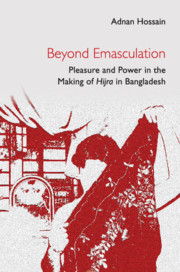Book contents
- Frontmatter
- Dedication
- Contents
- List of Figures
- Acknowledgements
- Introduction: Pleasure, Power and Masculinities
- 1 Kinship, Community and Hijragiri
- 2 Class-Cultural Politics and the Making of Hijras
- 3 Hijra Erotic Subjectivities: Pleasure, Practice and Power
- 4 The Paradox of Emasculation
- 5 Practices and Processes of Gendering
- 6 Love and Emotional Intimacy: Hijra Entanglement with Normative Bangla Men
- 7 Contemporary Transformation of Hijra Subjectivities
- Conclusion: Shifting Meaning and the Future of Hijras
- Glossary
- References
- Index
1 - Kinship, Community and Hijragiri
Published online by Cambridge University Press: 06 August 2021
- Frontmatter
- Dedication
- Contents
- List of Figures
- Acknowledgements
- Introduction: Pleasure, Power and Masculinities
- 1 Kinship, Community and Hijragiri
- 2 Class-Cultural Politics and the Making of Hijras
- 3 Hijra Erotic Subjectivities: Pleasure, Practice and Power
- 4 The Paradox of Emasculation
- 5 Practices and Processes of Gendering
- 6 Love and Emotional Intimacy: Hijra Entanglement with Normative Bangla Men
- 7 Contemporary Transformation of Hijra Subjectivities
- Conclusion: Shifting Meaning and the Future of Hijras
- Glossary
- References
- Index
Summary
One afternoon I was in the house of Joynob, a hijra guru, in Savar on the outskirts of Dhaka. Suddenly a few celas (disciples) of Joynob arrived after finishing their day's work. Handing Joynob cash and foodstuff collected from the bazaar, they started talking about two people they had encountered there. The celas explained that while on their way back, they had met two vabrajer chibrys, that is, hijras born straight from the wombs of their mothers. Dubious, Joynob's celas inspected those two persons and found that they had genital ambiguity. Those two individuals had stopped the hijra group and wanted to join them. Joynob was enraged and warned their celas to stay away from such people. Later Joynob argued that those ‘born hijras’ are dangerous and even looking at their faces can spell disaster.
The vignette above underscores one of the central concerns of this chapter: what is a hijra? If, as Joynob contends, those born hijras are dangerous, then what is the status of Joynob? What are their celas like? Are Joynob and their celas ‘real’ hijras and if so, on what basis do they make the claim to be such? In this chapter, I navigate these questions to better understand the contestation over what it means to be a hijra in Dhaka and the various markers of authenticity and differentiation that hijras employ to assert their identities.
In her monograph, Reddy (2005a) offers a contextual ethnography of variably situated koti groups in the context of the south Indian cities of Hyderabad and Secunderabad. ‘Koti’ serves as a generic all-encompassing identity within which several non-normatively oriented groups, including the hijras, belong. She contends that while several groups of male-born, feminine-identified koti groups exist there, these various groups often assert their moral superiority over others in a bid to claim authenticity. Her main contention is that all these groups identify sexual receptivity as central to their sense of koti identity, as opposed to men, whom they define in terms of the penetrative role. Stressing the fact that these groups are not reducible to gender and sexual difference alone, Reddy foregrounds various markers of differentiation, namely religion, class, language and desire, kinship, occupation and bodily practice as salient to the contextual construction of ‘thirdness’ and competing claims over authenticity.
- Type
- Chapter
- Information
- Beyond EmasculationPleasure and Power in the Making of <I>hijra</I> in Bangladesh, pp. 26 - 51Publisher: Cambridge University PressPrint publication year: 2021



